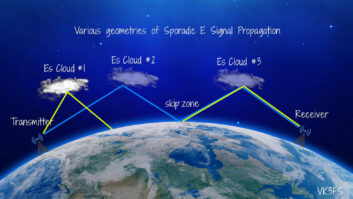I read with interest the recent discussion on revisiting the decision on the U.S. standard for FM broadcasting (“IBOC Has Been a Mistake,” Sept. 27). Was this decision wrong? Before we attempt to reinvent a 45-year-old standard that has stood the test of time, served us well and been adopted by other countries, we need to revisit the facts.
Subcarrier research dates back to Major Armstrong’s work in the early 1950s. Of interest is that two engineers working with Armstrong at the time were Murray G. Crosby and William G. Halstead, each of whom championed different approaches in FM stereo.
Introducing FM
FM broadcasting in the ’50s and early ’60s did not enjoy the financial attraction as it does now. AM broadcasting with its network radio attraction was very much king at that time. Many of those FM stations that did not simulcast their AM programming provided a background music service to stores, restaurants and offices via a technique known as simplex systems: a means of deriving an income in order to maintain financial visibility.
FM listeners tuning to those stations during the Simplex era heard the program along with the commercials. In the stores, restaurants and offices, the program was muted during those commercials. A muting relay installed in the receivers of subscribers was activated by a high-frequency signal in the subcarrier region of the FM signal and simply muted the receiver during the commercials.
Simplex was never enthusiastically received by the FCC, but was accepted in order to promote the new service of FM. FCC authorization to simplex was required prior to operation.
In 1955 Halstead petitioned the FCC to authorize concept of subcarriers and gained authorization for this new service. In 1958, the FCC issued an order denying the renewal of simplex authorizations by stating that the practice of simplexing did not agree with the basic concept of broadcasting given in the Communications Act.
By the late ’50s, the Hi-Fi craze was in full swing and the possibility of stereo broadcasting became a hot topic. An industry committee composed of receiver manufacturers, broadcasters and other interested parties formed the National Stereophonic Radio Committee to review the potential approaches to broadcast AM, FM and TV stereophonic broadcasting.
Although presentations for stereophonic AM, FM and TV were presented at that time, this small group soon reasoned that it was unrealistic to simultaneously consider the study of all three. Because FM was notably the emerging medium and the overwhelming choice of the Hi-Fi enthusiast, FM was the obvious choice to study first.
Designing the system
Fourteen FM stereo systems were submitted for consideration. Six of those were considered for further study and testing. Two utilized AM subcarriers (Zenith and GE), three utilized FM subcarriers (Crosby, Halstead and Calbest) and one (EMI-Percival) used a low bandwidth (100 Hz) steering signal to carry left/right directional information.
These six systems were tested in July and August of 1960. The committee chose KDKA(FM) in Pittsburgh as the host for the transmitting facility and located the receiving site at a motel in Uniontown, Pa. All tests were conducted using the same transmitting and receiving facilities for all proponents. The H.H. Scott Company provided a standard receiver to each system proponent for use at the receiving site.
As a result, all systems tested used the same transmitter and antenna, as well as the same receiving antenna and receiver. Stereo generators and multiplex adaptors were the responsibility and the design of each proponent.
Each proponent had evaluated tradeoffs associated with their design. Each took different, or in some cases slightly different, approaches in the design of their FM stereo system. The actual tests confirmed these differences.
Both the AM systems (Zenith and GE) offered stereo separation to 15 kHz, good main channel or monophonic signal-to-noise, but suffered in subcarrier signal-to-noise compared with their FM counterparts.
The wideband subcarrier system submitted by Crosby offered stereo separation to 15 kHz. FM subcarrier limiting provided a somewhat better noise performance that that of the two AM subcarrier systems. However, a wider than traditional SCA bandwidth was required in order to accommodate 15 kHz frequency response plus subcarrier deviation.
The wider bandwidth permitted an increase in the noise to the subcarrier. Thus, the signal-to-noise performance of this subcarrier, while performing better than the two AM systems, did not perform as well as either of the two narrowband systems. A second factor, associated with the bandwidth and the deviation of the wideband subcarrier, required a reduction in deviation of the main or monophobic channel deviation by 6 dB, thereby reducing the main channel signal to noise performance by 6 dB as well.
The two narrow band FM systems (Halstead and Calbest) were both adaptations of a standard SCA channel. In order to fit within the bandwidth of the subcarrier high frequency, response of the subcarrier had to be limited. Halstead limited the stereo separation to 8000 Hz, and Calbest to 3500 Hz. The reasoning supporting the reduction in audio frequency separation was premised on the perception of little to no audible directional information in the octave of 8,000 to 15,000 Hz.
The net gain here was that a narrow-band channel with limiting would offer better signal-to-noise without an audible loss in the stereophonic effect. While some listening tests claim there was an audible difference in the separation, other tests claim that there was no audible difference. These systems, however, did offer the best signal-to-noise performance. Both offered very good main channel or monophobic signal-to-noise as well.
From the source
As the one who actually conducted those noise performance measurements on each of the systems tested, I can attest that the results of those measurements did confirm the theory anticipated for each of the systems as given.
Here is what we learned: Anytime there is an attempt to put two pounds in a one-pound bag, there are going to be tradeoffs. Each tradeoff needs to be evaluated. Eventually each aspect in the tradeoff needs to be ranked by preference. The actual decision is a result of those preferences.
The two AM systems offered full 15 kHz separation, good monophobic signal to noise, good spectrum management with the use of an AM subcarrier, allowing for a SCA carrier to be included, but were reduced in signal-to-noise on the stereo subcarrier.
The wideband FM system offered full 15 kHz separation, a better subcarrier signal-to-noise that that of the two AM subcarrier systems, but not as good as achieved with either of the two narrow-band subcarrier systems. Its wideband subcarrier requirement resulted in reduced signal-to-noise performance of the main or monophobic carrier. The same wideband subcarrier requirement also negated the use of any SCA carrier.
The two narrow-band FM systems offered the better subcarrier signal-to-noise performance but were limited in reduced high-frequency audio separation. Both offered good spectrum management with room for an SCA carrier.
How would you rate the systems presented?
Comment on this or any other article by e-mailing [email protected]







